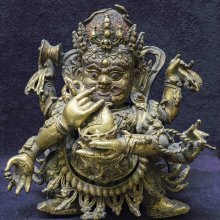Shadbhuja, Ṣaḍbhuja, Shash-bhuja: 12 definitions
Introduction:
Shadbhuja means something in Buddhism, Pali, Hinduism, Sanskrit, Marathi. If you want to know the exact meaning, history, etymology or English translation of this term then check out the descriptions on this page. Add your comment or reference to a book if you want to contribute to this summary article.
The Sanskrit term Ṣaḍbhuja can be transliterated into English as Sadbhuja or Shadbhuja, using the IAST transliteration scheme (?).
Images (photo gallery)
(+5 more images available)
In Hinduism
Shaktism (Shakta philosophy)
Source: Google Books: ManthanabhairavatantramṢaḍbhujā (षड्भुजा) refers to “she who has two arms” and is used to described the Goddess (i.e., Khageśī), according to the second recension of the Yogakhaṇḍa of the Manthānabhairavatantra, a vast sprawling work that belongs to a corpus of Tantric texts concerned with the worship of the goddess Kubjikā.—Accordingly, “In the meantime, once the goddess had crossed over the most excellent Yoga and once the fifth night had passed, she emerged from the middle of the Liṅga. [...] She (also has other forms with) two or six arms [i.e., ṣaḍbhujā] and, beautiful, sits on five ghosts. In the left hand (she holds) a skull and (in her other) upraised hands (she holds a) noose and spear. Crooked, her body grey, she is Cāmuṇḍā, the accomplished Yoginī. This Vidyā, of many forms, is the woman who resides within the Triangle. Such is the visualized form of the goddess, the deity called Khageśī”.

Shakta (शाक्त, śākta) or Shaktism (śāktism) represents a tradition of Hinduism where the Goddess (Devi) is revered and worshipped. Shakta literature includes a range of scriptures, including various Agamas and Tantras, although its roots may be traced back to the Vedas.
Shaivism (Shaiva philosophy)
Source: SOAS University of London: Protective Rites in the Netra TantraṢaḍbhuja (षड्भुज) refers to “six arms”, and is used to describe Viṣṇu, according to the Netratantra of Kṣemarāja: a Śaiva text from the 9th century in which Śiva (Bhairava) teaches Pārvatī topics such as metaphysics, cosmology, and soteriology.—Accordingly, [verse 13.1-9, while describing the appearance and worship of Viṣṇu, in the form of Nārāyaṇa]—“[...] Or, he should meditate [on Nārāyaṇa] atop Garuḍa, Śrī at his side. [He should visualize Viṣṇu] very white and beautiful [with] three faces [that] resemble the moon, six arms (ṣaḍbhuja—bhujaiḥ ṣaḍbhiḥ samāyuktaṃ) , decorated like Varāha Hari, [his hands] endowed with [the shapes of] wish-granting and protection. Śrī is of the same color and holds the same weapons, suitably beautiful and charming before the eyes of Devadeva. [...]”.

Shaiva (शैव, śaiva) or Shaivism (śaivism) represents a tradition of Hinduism worshiping Shiva as the supreme being. Closely related to Shaktism, Shaiva literature includes a range of scriptures, including Tantras, while the root of this tradition may be traced back to the ancient Vedas.
In Buddhism
Tibetan Buddhism (Vajrayana or tantric Buddhism)
Source: Wisdom Library: Tibetan BuddhismṢaḍbhuja (षड्भुज) is the name of Vidyārāja (i.e., “wisdom king”) mentioned as attending the teachings in the 6th century Mañjuśrīmūlakalpa: one of the largest Kriyā Tantras devoted to Mañjuśrī (the Bodhisattva of wisdom) representing an encyclopedia of knowledge primarily concerned with ritualistic elements in Buddhism. The teachings in this text originate from Mañjuśrī and were taught to and by Buddha Śākyamuni in the presence of a large audience (including Ṣaḍbhuja).
Source: archive.org: The Indian Buddhist IconographyṢaḍbhuja (षड्भुज) or Ṣaḍbhuja-Sitatārā refers to a deity from the White Tārā family, according to Buddhist Iconography.—As she [viz., Ṣaḍbhuja-Sitatārā] bears the image of Amoghasiddhi on the crown, her form has already been described. She is three-faced and six-armed and has no companions. [...] Strictly speaking, only those deities can be called Tārās to whom the mantra: “oṃ tārā tuttāre ture svāhā” is assigned. [...] From the colour of the different Tārās it will be possible to refer them [viz., Ṣaḍbhuja] to their respective Kulas or families presided over by the five Dhyāni Buddhas.

Tibetan Buddhism includes schools such as Nyingma, Kadampa, Kagyu and Gelug. Their primary canon of literature is divided in two broad categories: The Kangyur, which consists of Buddha’s words, and the Tengyur, which includes commentaries from various sources. Esotericism and tantra techniques (vajrayāna) are collected indepently.
Languages of India and abroad
Marathi-English dictionary
Source: DDSA: The Molesworth Marathi and English Dictionaryṣaḍbhuja (षड्भुज).—a S Six-armed. 2 Six-sided, hexagonal: also as s m a hexagon.
Marathi is an Indo-European language having over 70 million native speakers people in (predominantly) Maharashtra India. Marathi, like many other Indo-Aryan languages, evolved from early forms of Prakrit, which itself is a subset of Sanskrit, one of the most ancient languages of the world.
Sanskrit dictionary
Source: DDSA: The practical Sanskrit-English dictionaryṢaḍbhuja (षड्भुज).—a. (-ṣaḍbhuja) 1 six-armed.
2) six-sided, hexagonal.
-jaḥ a hexagon. (-jā) 1 an epithet of Durgā.
Ṣaḍbhuja is a Sanskrit compound consisting of the terms ṣaṣ and bhuja (भुज).
Source: Cologne Digital Sanskrit Dictionaries: Shabda-Sagara Sanskrit-English DictionaryṢaḍbhuja (षड्भुज).—mfn.
(-jaḥ-jā-jaṃ) Six armed, six-sided. m.
(-jaḥ) A hexagon. f.
(-jā) The water-melon. “kharamuja.” E. ṣaṣ six, bhuja an arm or branch, &c., aff. ṭāp.
Source: Cologne Digital Sanskrit Dictionaries: Cappeller Sanskrit-English DictionaryṢaḍbhuja (षड्भुज).—[adjective] six-armed.
Source: Cologne Digital Sanskrit Dictionaries: Monier-Williams Sanskrit-English Dictionary1) Ṣaḍbhuja (षड्भुज):—[=ṣaḍ-bhuja] [from ṣaḍ > ṣaṣ] mf(ā)n. six-armed, [Pañcarātra]
2) [v.s. ...] six-sided
3) [v.s. ...] m. or n. (?) a hexagon, [Colebrooke]
4) Ṣaḍbhujā (षड्भुजा):—[=ṣaḍ-bhujā] [from ṣaḍ-bhuja > ṣaḍ > ṣaṣ] f. Name of Durgā, [cf. Lexicographers, esp. such as amarasiṃha, halāyudha, hemacandra, etc.]
5) [v.s. ...] a water-melon, [cf. Lexicographers, esp. such as amarasiṃha, halāyudha, hemacandra, etc.]
Source: Cologne Digital Sanskrit Dictionaries: Yates Sanskrit-English DictionaryṢaḍbhujā (षड्भुजा):—[ṣaḍ-bhujā] (jā) 1. f. A water-melon. a. Having six sides.
[Sanskrit to German]
Sanskrit, also spelled संस्कृतम् (saṃskṛtam), is an ancient language of India commonly seen as the grandmother of the Indo-European language family (even English!). Closely allied with Prakrit and Pali, Sanskrit is more exhaustive in both grammar and terms and has the most extensive collection of literature in the world, greatly surpassing its sister-languages Greek and Latin.
Kannada-English dictionary
Source: Alar: Kannada-English corpusṢaḍbhuja (ಷಡ್ಭುಜ):—[noun] a plane figure with six angles and six sides; a hexagon.
Kannada is a Dravidian language (as opposed to the Indo-European language family) mainly spoken in the southwestern region of India.
See also (Relevant definitions)
Partial matches: Shash, Bhuja, Sat.
Starts with: Shadbhujajnananatha, Shadbhujasaute, Shadbhujasitatara.
Full-text: Vrittakarkati, Vrittervaru, Shadrekha, Madhuphala, Jnananatha, Shanmukha, Tikta.
Relevant text
Search found 4 books and stories containing Shadbhuja, Ṣaḍbhuja, Ṣaḍ-bhujā, Sad-bhuja, Ṣaḍ-bhuja, Shad-bhuja, Sas-bhuja, Ṣaṣ-bhuja, Sadbhuja, Ṣaḍbhujā, Shash-bhuja, Ṣaṣ-bhujā; (plurals include: Shadbhujas, Ṣaḍbhujas, bhujās, bhujas, Sadbhujas, Ṣaḍbhujās). You can also click to the full overview containing English textual excerpts. Below are direct links for the most relevant articles:
Chaitanya Bhagavata (by Bhumipati Dāsa)
Verse 1.1.122 < [Chapter 1 - Summary of Lord Gaura’s Pastimes]
Verse 2.5.94 < [Chapter 5 - Lord Nityānanda’s Vyāsa-pūjā Ceremony and His Darśana of the Lord’s Six-armed Form]
Verse 2.5.131 < [Chapter 5 - Lord Nityānanda’s Vyāsa-pūjā Ceremony and His Darśana of the Lord’s Six-armed Form]
The Indian Buddhist Iconography (by Benoytosh Bhattachacharyya)
Vastu-shastra (1): Canons of Architecture (by D. N. Shukla)
(ii) The Site-planning (Vāstupada-vīnyāsa) < [Chapter 6 - Fundamental Canons of Hindu Architecture]
Related products





